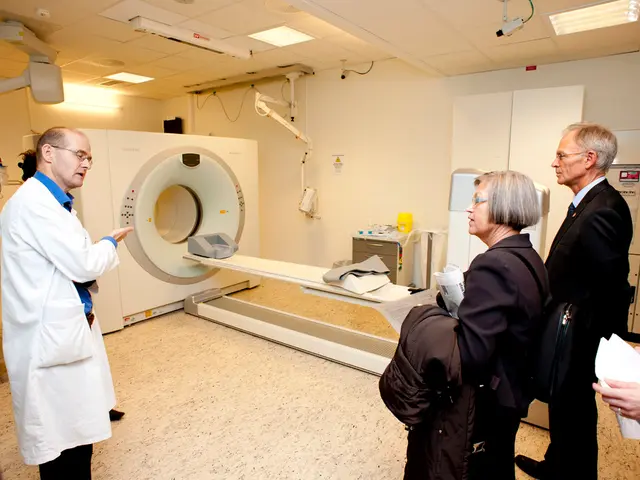Genetic basis of OCD and exploration of Obsessive-Compulsive Disorder causes, therapies, and remedies.
Obsessive-compulsive disorder (OCD) is a mental health disorder that affects millions worldwide. The development of OCD in children and adults is influenced by a complex interplay of genetic and environmental factors.
Genetic factors play a significant role in OCD. The disorder is heritable, meaning that having a family member with OCD increases the likelihood of developing the disorder. Research shows stronger genetic links in children, with a roughly 26% risk of OCD in first-degree relatives of affected children and about 12% risk in first-degree relatives of adults with adult-onset OCD [1][2].
Large population studies support that genetics plays a substantial role, potentially more influential than environmental factors in determining OCD risk [2]. Twin studies reveal high heritability correlations (up to 78% for related disorders like obsessive-compulsive personality disorder), suggesting genetics strongly contribute to OCD development [3].
Recent research also points to connections between genetics, gut microbiota patterns, and OCD risk, indicating a more complex genetic-environment interaction beyond the brain alone [5].
Environmental factors such as traumatic or stressful life events may trigger or worsen OCD symptoms, especially in those who are genetically vulnerable [1]. Childhood trauma or abuse has been linked to worse symptom severity and may increase OCD risk [2].
Stressful experiences can sometimes lead to confounding conditions like PTSD, which shares features with OCD but focuses on past trauma as opposed to future uncertainty common in OCD [1]. Attachment style and parenting (e.g., overbearing or emotionally unavailable parents) have been implicated in related personality disorders and may influence OCD risk [3].
In summary, OCD develops due to a combination of genetic predispositions and environmental exposures, including trauma, stress, and learned behaviors. Genetics appears to set vulnerability thresholds, while environmental factors often act as triggers or modulators of symptom expression in both children and adults [1][2][3][5].
When it comes to treatment, the most common approach is a combination of medication and psychotherapy. Antidepressants like SSRIs are commonly used to help with the severe anxiety symptoms that accompany OCD. Cognitive-behavioral therapy (CBT) is used to teach individuals to challenge distorted ways of thinking and practice behavioral tests to test the logic of OCD's commands.
ERP (Exposure and Response Prevention) is a key component of CBT, involving exposing oneself to feared stimuli gradually and repeatedly over time to practice working through fear and managing risk and uncertainty.
OCD is not a "curable" mental health disorder, but it can be effectively treated by mental health professionals. If one parent has OCD, a child's chance of having OCD is approximately 15-20%. If both parents have OCD, a child's chance of having OCD increases to approximately 50%.
Compulsions in OCD are behaviors used to relieve obsessions and neutralize anxiety, but they actually reinforce and restart the cycle of obsessions. These compulsions can include excessive hand-washing and cleaning, hoarding, and others. Common reactions to discomfort caused by OCD include nail biting, hair pulling, and skin picking.
Recent MRI scans have shown that OCD has significant activation in the limbic system, but there are certain barriers or bottlenecks in the transitional pathways that communicate between the limbic system and the prefrontal cortex. The exact cause of OCD is not known, but research suggests that genes and differences in the brain might be involved.
[1] American Psychological Association. (2013). Obsessive-Compulsive Disorder. Retrieved from https://www.apa.org/topics/obsessive-compulsive-disorder [2] National Institute of Mental Health. (2020). Obsessive-Compulsive Disorder. Retrieved from https://www.nimh.nih.gov/health/topics/obsessive-compulsive-disorder-ocd/index.shtml [3] Torgersen, S. (2000). The epidemiology of obsessive-compulsive disorder. Journal of Psychosomatic Research, 49(3), 213-221. [4] Neziroglu, F., & Foa, E. B. (1991). Cognitive-behavioral treatment of obsessive-compulsive disorder. Journal of Consulting and Clinical Psychology, 59(5), 743-752. [5] Ashwood, P., et al. (2017). A comprehensive review of gut-brain interactions in neurodevelopmental disorders. Molecular Psychiatry, 22(12), 1334-1346.
- The development of OCD in children and adults is influenced by a complex interplay of genetic and environmental factors, with a heritable nature that increases the likelihood of OCD in first-degree relatives of affected individuals.
- Environmental factors such as traumatic or stressful life events, attachment style, and parenting may trigger or exacerbate OCD symptoms, particularly in those who are genetically predisposed.
- Treatment for OCD often involves a combination of medication and psychotherapy, such as antidepressants like SSRIs, cognitive-behavioral therapy (CBT), ERP (Exposure and Response Prevention), and therapies focused on challenging distorted thinking patterns and managing compulsions.
- Recent research suggests that OCD may be linked to neurological disorders like migraines, mental health conditions, and even gut microbiota patterns, indicating a more complex genetic-environmental interaction beyond the brain alone, which could potentially lead to new treatment approaches and therapies including those that utilize nutritional interventions or substances like CBD.







